Child Development and John Hassall, Nursery Frieze Art Museums
VerifiedAdded on 2023/04/21
|17
|4208
|361
AI Summary
This paper critically discusses how John Hassall, Nursery Frieze Art Museums have been of greater significance in enhancing children development. It explores various fundamental theories of child development guiding the museum and factors affecting child development. It also discusses the importance of children visiting the museum, how it promotes critical thinking skills, encourages play, and enhances creativity. Additionally, it highlights the role of museums in fostering lifelong learning and innovation in child development.
Contribute Materials
Your contribution can guide someone’s learning journey. Share your
documents today.

Sociology
Name
Institution
Professor
Course
Date
Name
Institution
Professor
Course
Date
Secure Best Marks with AI Grader
Need help grading? Try our AI Grader for instant feedback on your assignments.
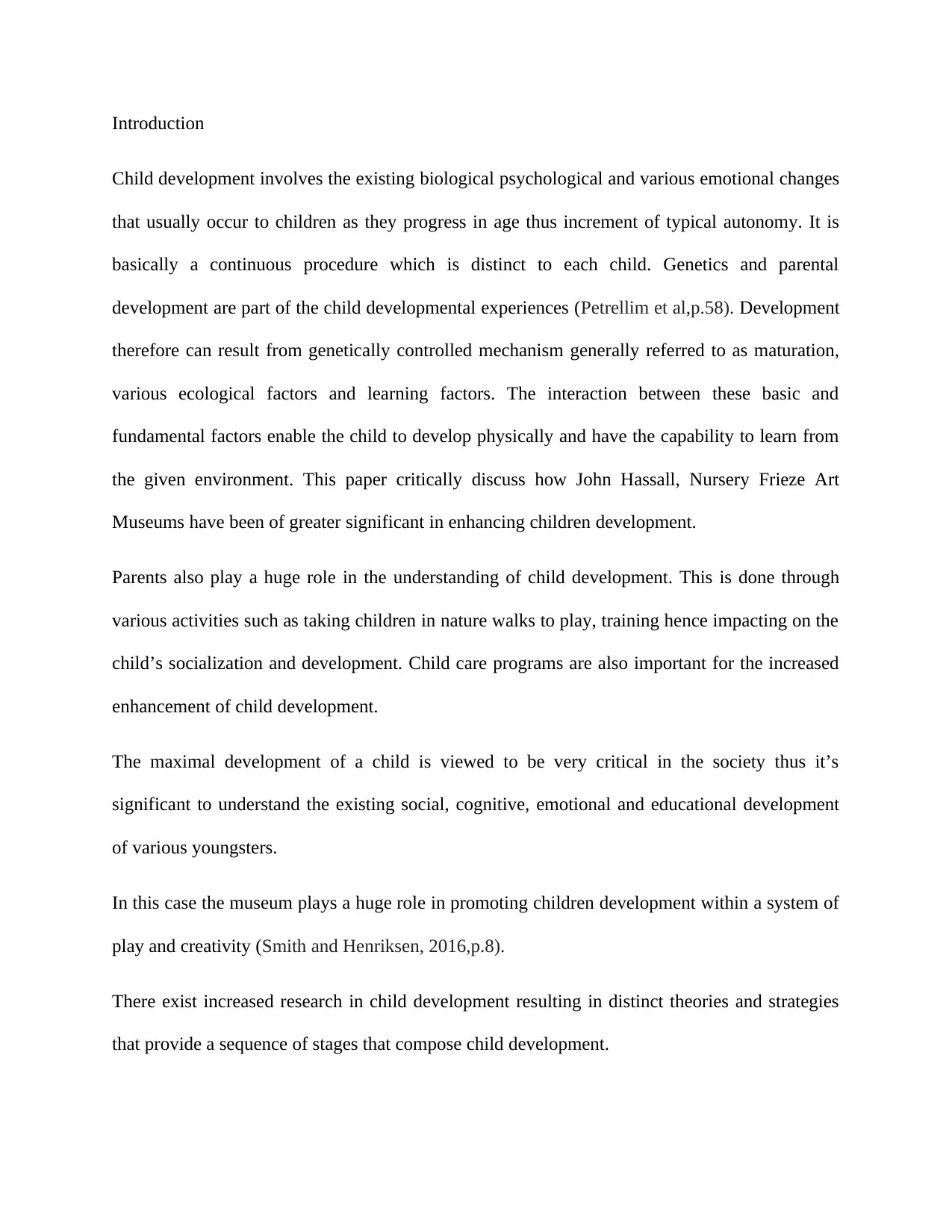
Introduction
Child development involves the existing biological psychological and various emotional changes
that usually occur to children as they progress in age thus increment of typical autonomy. It is
basically a continuous procedure which is distinct to each child. Genetics and parental
development are part of the child developmental experiences (Petrellim et al,p.58). Development
therefore can result from genetically controlled mechanism generally referred to as maturation,
various ecological factors and learning factors. The interaction between these basic and
fundamental factors enable the child to develop physically and have the capability to learn from
the given environment. This paper critically discuss how John Hassall, Nursery Frieze Art
Museums have been of greater significant in enhancing children development.
Parents also play a huge role in the understanding of child development. This is done through
various activities such as taking children in nature walks to play, training hence impacting on the
child’s socialization and development. Child care programs are also important for the increased
enhancement of child development.
The maximal development of a child is viewed to be very critical in the society thus it’s
significant to understand the existing social, cognitive, emotional and educational development
of various youngsters.
In this case the museum plays a huge role in promoting children development within a system of
play and creativity (Smith and Henriksen, 2016,p.8).
There exist increased research in child development resulting in distinct theories and strategies
that provide a sequence of stages that compose child development.
Child development involves the existing biological psychological and various emotional changes
that usually occur to children as they progress in age thus increment of typical autonomy. It is
basically a continuous procedure which is distinct to each child. Genetics and parental
development are part of the child developmental experiences (Petrellim et al,p.58). Development
therefore can result from genetically controlled mechanism generally referred to as maturation,
various ecological factors and learning factors. The interaction between these basic and
fundamental factors enable the child to develop physically and have the capability to learn from
the given environment. This paper critically discuss how John Hassall, Nursery Frieze Art
Museums have been of greater significant in enhancing children development.
Parents also play a huge role in the understanding of child development. This is done through
various activities such as taking children in nature walks to play, training hence impacting on the
child’s socialization and development. Child care programs are also important for the increased
enhancement of child development.
The maximal development of a child is viewed to be very critical in the society thus it’s
significant to understand the existing social, cognitive, emotional and educational development
of various youngsters.
In this case the museum plays a huge role in promoting children development within a system of
play and creativity (Smith and Henriksen, 2016,p.8).
There exist increased research in child development resulting in distinct theories and strategies
that provide a sequence of stages that compose child development.
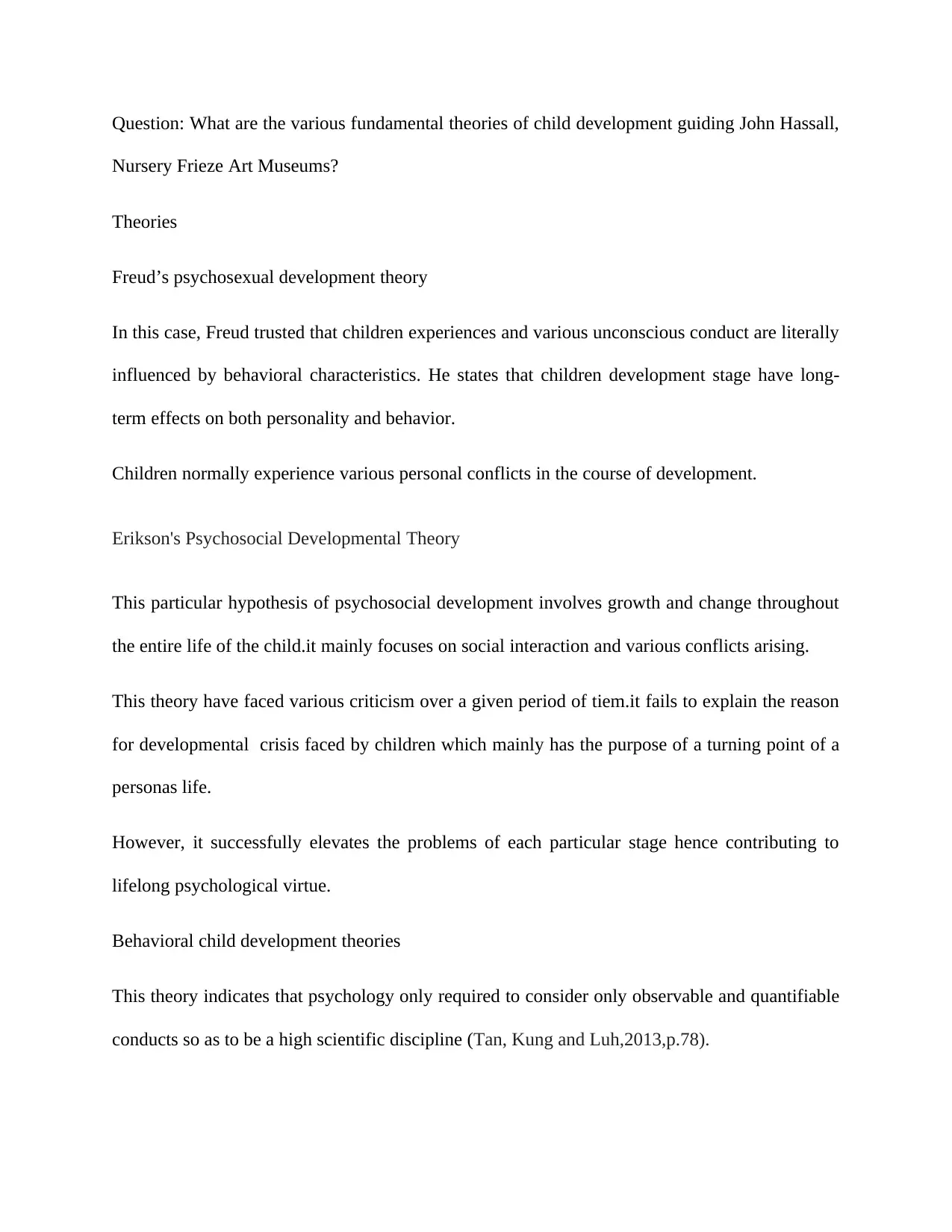
Question: What are the various fundamental theories of child development guiding John Hassall,
Nursery Frieze Art Museums?
Theories
Freud’s psychosexual development theory
In this case, Freud trusted that children experiences and various unconscious conduct are literally
influenced by behavioral characteristics. He states that children development stage have long-
term effects on both personality and behavior.
Children normally experience various personal conflicts in the course of development.
Erikson's Psychosocial Developmental Theory
This particular hypothesis of psychosocial development involves growth and change throughout
the entire life of the child.it mainly focuses on social interaction and various conflicts arising.
This theory have faced various criticism over a given period of tiem.it fails to explain the reason
for developmental crisis faced by children which mainly has the purpose of a turning point of a
personas life.
However, it successfully elevates the problems of each particular stage hence contributing to
lifelong psychological virtue.
Behavioral child development theories
This theory indicates that psychology only required to consider only observable and quantifiable
conducts so as to be a high scientific discipline (Tan, Kung and Luh,2013,p.78).
Nursery Frieze Art Museums?
Theories
Freud’s psychosexual development theory
In this case, Freud trusted that children experiences and various unconscious conduct are literally
influenced by behavioral characteristics. He states that children development stage have long-
term effects on both personality and behavior.
Children normally experience various personal conflicts in the course of development.
Erikson's Psychosocial Developmental Theory
This particular hypothesis of psychosocial development involves growth and change throughout
the entire life of the child.it mainly focuses on social interaction and various conflicts arising.
This theory have faced various criticism over a given period of tiem.it fails to explain the reason
for developmental crisis faced by children which mainly has the purpose of a turning point of a
personas life.
However, it successfully elevates the problems of each particular stage hence contributing to
lifelong psychological virtue.
Behavioral child development theories
This theory indicates that psychology only required to consider only observable and quantifiable
conducts so as to be a high scientific discipline (Tan, Kung and Luh,2013,p.78).
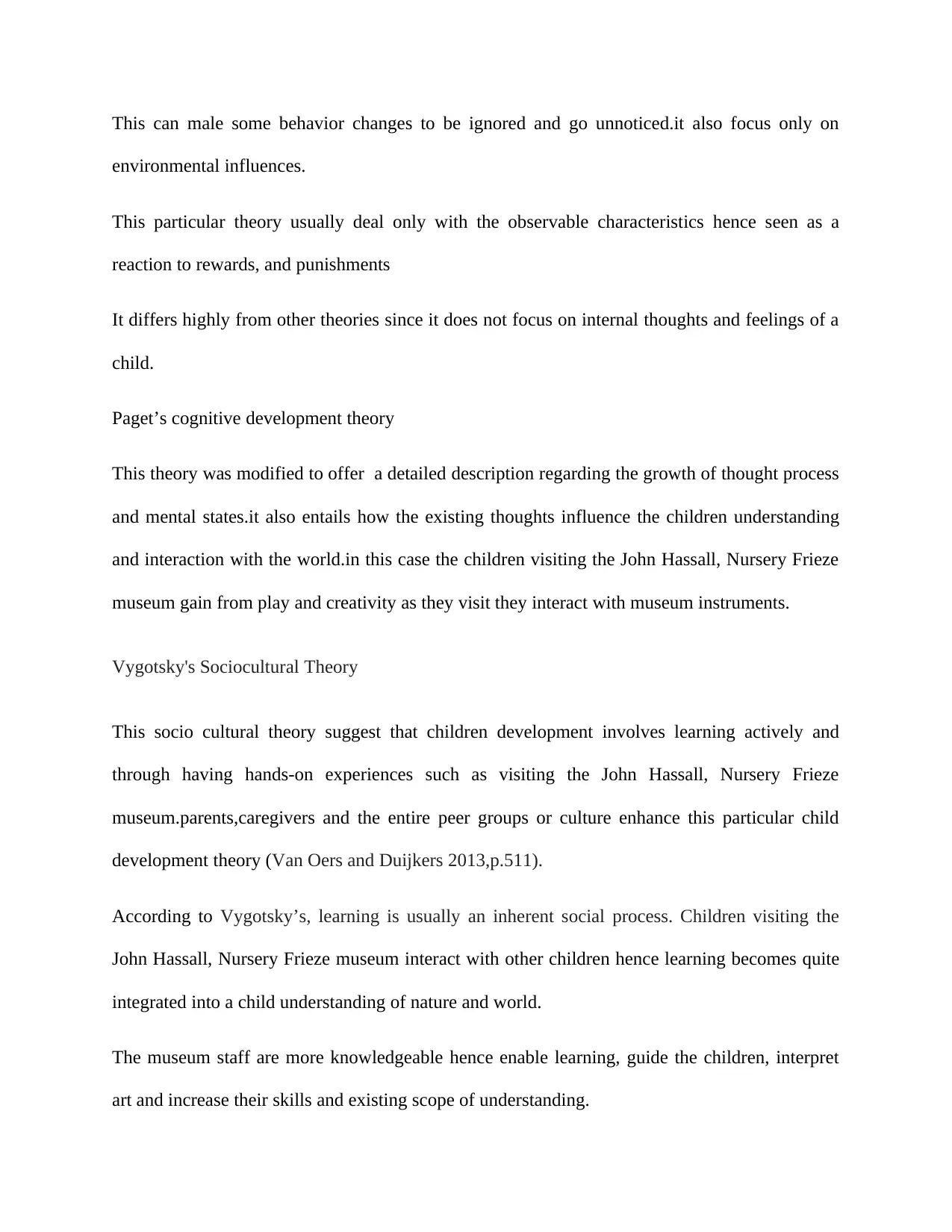
This can male some behavior changes to be ignored and go unnoticed.it also focus only on
environmental influences.
This particular theory usually deal only with the observable characteristics hence seen as a
reaction to rewards, and punishments
It differs highly from other theories since it does not focus on internal thoughts and feelings of a
child.
Paget’s cognitive development theory
This theory was modified to offer a detailed description regarding the growth of thought process
and mental states.it also entails how the existing thoughts influence the children understanding
and interaction with the world.in this case the children visiting the John Hassall, Nursery Frieze
museum gain from play and creativity as they visit they interact with museum instruments.
Vygotsky's Sociocultural Theory
This socio cultural theory suggest that children development involves learning actively and
through having hands-on experiences such as visiting the John Hassall, Nursery Frieze
museum.parents,caregivers and the entire peer groups or culture enhance this particular child
development theory (Van Oers and Duijkers 2013,p.511).
According to Vygotsky’s, learning is usually an inherent social process. Children visiting the
John Hassall, Nursery Frieze museum interact with other children hence learning becomes quite
integrated into a child understanding of nature and world.
The museum staff are more knowledgeable hence enable learning, guide the children, interpret
art and increase their skills and existing scope of understanding.
environmental influences.
This particular theory usually deal only with the observable characteristics hence seen as a
reaction to rewards, and punishments
It differs highly from other theories since it does not focus on internal thoughts and feelings of a
child.
Paget’s cognitive development theory
This theory was modified to offer a detailed description regarding the growth of thought process
and mental states.it also entails how the existing thoughts influence the children understanding
and interaction with the world.in this case the children visiting the John Hassall, Nursery Frieze
museum gain from play and creativity as they visit they interact with museum instruments.
Vygotsky's Sociocultural Theory
This socio cultural theory suggest that children development involves learning actively and
through having hands-on experiences such as visiting the John Hassall, Nursery Frieze
museum.parents,caregivers and the entire peer groups or culture enhance this particular child
development theory (Van Oers and Duijkers 2013,p.511).
According to Vygotsky’s, learning is usually an inherent social process. Children visiting the
John Hassall, Nursery Frieze museum interact with other children hence learning becomes quite
integrated into a child understanding of nature and world.
The museum staff are more knowledgeable hence enable learning, guide the children, interpret
art and increase their skills and existing scope of understanding.
Secure Best Marks with AI Grader
Need help grading? Try our AI Grader for instant feedback on your assignments.
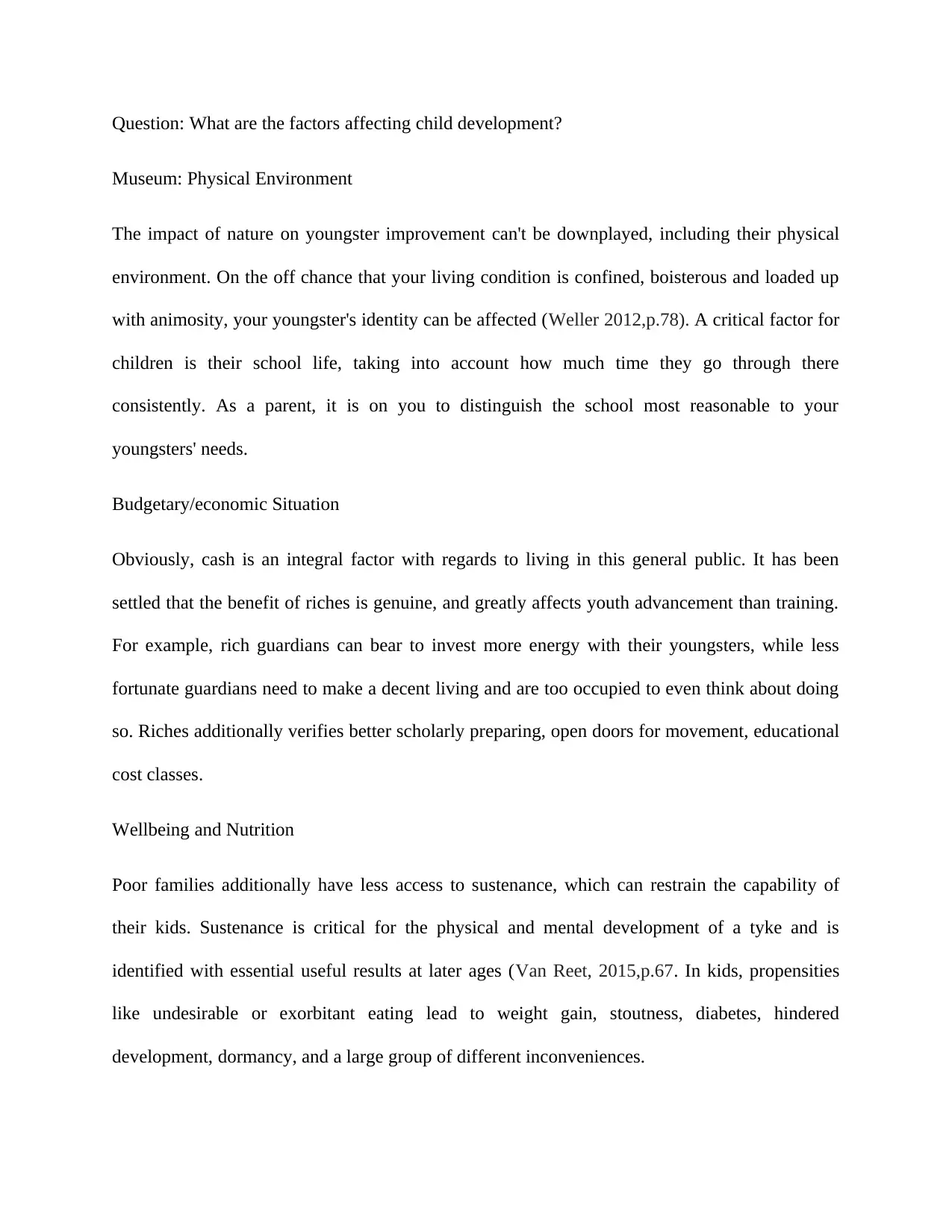
Question: What are the factors affecting child development?
Museum: Physical Environment
The impact of nature on youngster improvement can't be downplayed, including their physical
environment. On the off chance that your living condition is confined, boisterous and loaded up
with animosity, your youngster's identity can be affected (Weller 2012,p.78). A critical factor for
children is their school life, taking into account how much time they go through there
consistently. As a parent, it is on you to distinguish the school most reasonable to your
youngsters' needs.
Budgetary/economic Situation
Obviously, cash is an integral factor with regards to living in this general public. It has been
settled that the benefit of riches is genuine, and greatly affects youth advancement than training.
For example, rich guardians can bear to invest more energy with their youngsters, while less
fortunate guardians need to make a decent living and are too occupied to even think about doing
so. Riches additionally verifies better scholarly preparing, open doors for movement, educational
cost classes.
Wellbeing and Nutrition
Poor families additionally have less access to sustenance, which can restrain the capability of
their kids. Sustenance is critical for the physical and mental development of a tyke and is
identified with essential useful results at later ages (Van Reet, 2015,p.67. In kids, propensities
like undesirable or exorbitant eating lead to weight gain, stoutness, diabetes, hindered
development, dormancy, and a large group of different inconveniences.
Museum: Physical Environment
The impact of nature on youngster improvement can't be downplayed, including their physical
environment. On the off chance that your living condition is confined, boisterous and loaded up
with animosity, your youngster's identity can be affected (Weller 2012,p.78). A critical factor for
children is their school life, taking into account how much time they go through there
consistently. As a parent, it is on you to distinguish the school most reasonable to your
youngsters' needs.
Budgetary/economic Situation
Obviously, cash is an integral factor with regards to living in this general public. It has been
settled that the benefit of riches is genuine, and greatly affects youth advancement than training.
For example, rich guardians can bear to invest more energy with their youngsters, while less
fortunate guardians need to make a decent living and are too occupied to even think about doing
so. Riches additionally verifies better scholarly preparing, open doors for movement, educational
cost classes.
Wellbeing and Nutrition
Poor families additionally have less access to sustenance, which can restrain the capability of
their kids. Sustenance is critical for the physical and mental development of a tyke and is
identified with essential useful results at later ages (Van Reet, 2015,p.67. In kids, propensities
like undesirable or exorbitant eating lead to weight gain, stoutness, diabetes, hindered
development, dormancy, and a large group of different inconveniences.
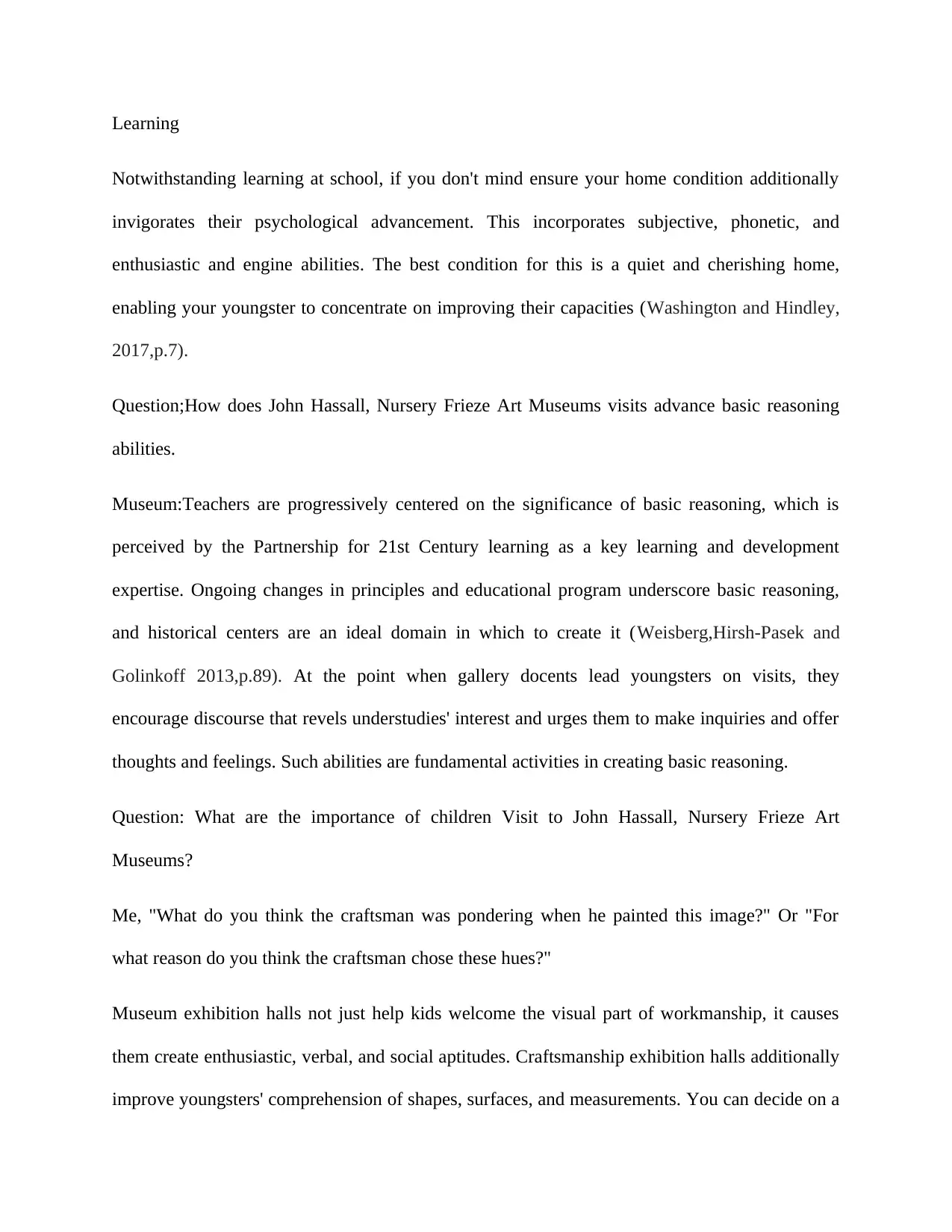
Learning
Notwithstanding learning at school, if you don't mind ensure your home condition additionally
invigorates their psychological advancement. This incorporates subjective, phonetic, and
enthusiastic and engine abilities. The best condition for this is a quiet and cherishing home,
enabling your youngster to concentrate on improving their capacities (Washington and Hindley,
2017,p.7).
Question;How does John Hassall, Nursery Frieze Art Museums visits advance basic reasoning
abilities.
Museum:Teachers are progressively centered on the significance of basic reasoning, which is
perceived by the Partnership for 21st Century learning as a key learning and development
expertise. Ongoing changes in principles and educational program underscore basic reasoning,
and historical centers are an ideal domain in which to create it (Weisberg,Hirsh‐Pasek and
Golinkoff 2013,p.89). At the point when gallery docents lead youngsters on visits, they
encourage discourse that revels understudies' interest and urges them to make inquiries and offer
thoughts and feelings. Such abilities are fundamental activities in creating basic reasoning.
Question: What are the importance of children Visit to John Hassall, Nursery Frieze Art
Museums?
Me, "What do you think the craftsman was pondering when he painted this image?" Or "For
what reason do you think the craftsman chose these hues?"
Museum exhibition halls not just help kids welcome the visual part of workmanship, it causes
them create enthusiastic, verbal, and social aptitudes. Craftsmanship exhibition halls additionally
improve youngsters' comprehension of shapes, surfaces, and measurements. You can decide on a
Notwithstanding learning at school, if you don't mind ensure your home condition additionally
invigorates their psychological advancement. This incorporates subjective, phonetic, and
enthusiastic and engine abilities. The best condition for this is a quiet and cherishing home,
enabling your youngster to concentrate on improving their capacities (Washington and Hindley,
2017,p.7).
Question;How does John Hassall, Nursery Frieze Art Museums visits advance basic reasoning
abilities.
Museum:Teachers are progressively centered on the significance of basic reasoning, which is
perceived by the Partnership for 21st Century learning as a key learning and development
expertise. Ongoing changes in principles and educational program underscore basic reasoning,
and historical centers are an ideal domain in which to create it (Weisberg,Hirsh‐Pasek and
Golinkoff 2013,p.89). At the point when gallery docents lead youngsters on visits, they
encourage discourse that revels understudies' interest and urges them to make inquiries and offer
thoughts and feelings. Such abilities are fundamental activities in creating basic reasoning.
Question: What are the importance of children Visit to John Hassall, Nursery Frieze Art
Museums?
Me, "What do you think the craftsman was pondering when he painted this image?" Or "For
what reason do you think the craftsman chose these hues?"
Museum exhibition halls not just help kids welcome the visual part of workmanship, it causes
them create enthusiastic, verbal, and social aptitudes. Craftsmanship exhibition halls additionally
improve youngsters' comprehension of shapes, surfaces, and measurements. You can decide on a
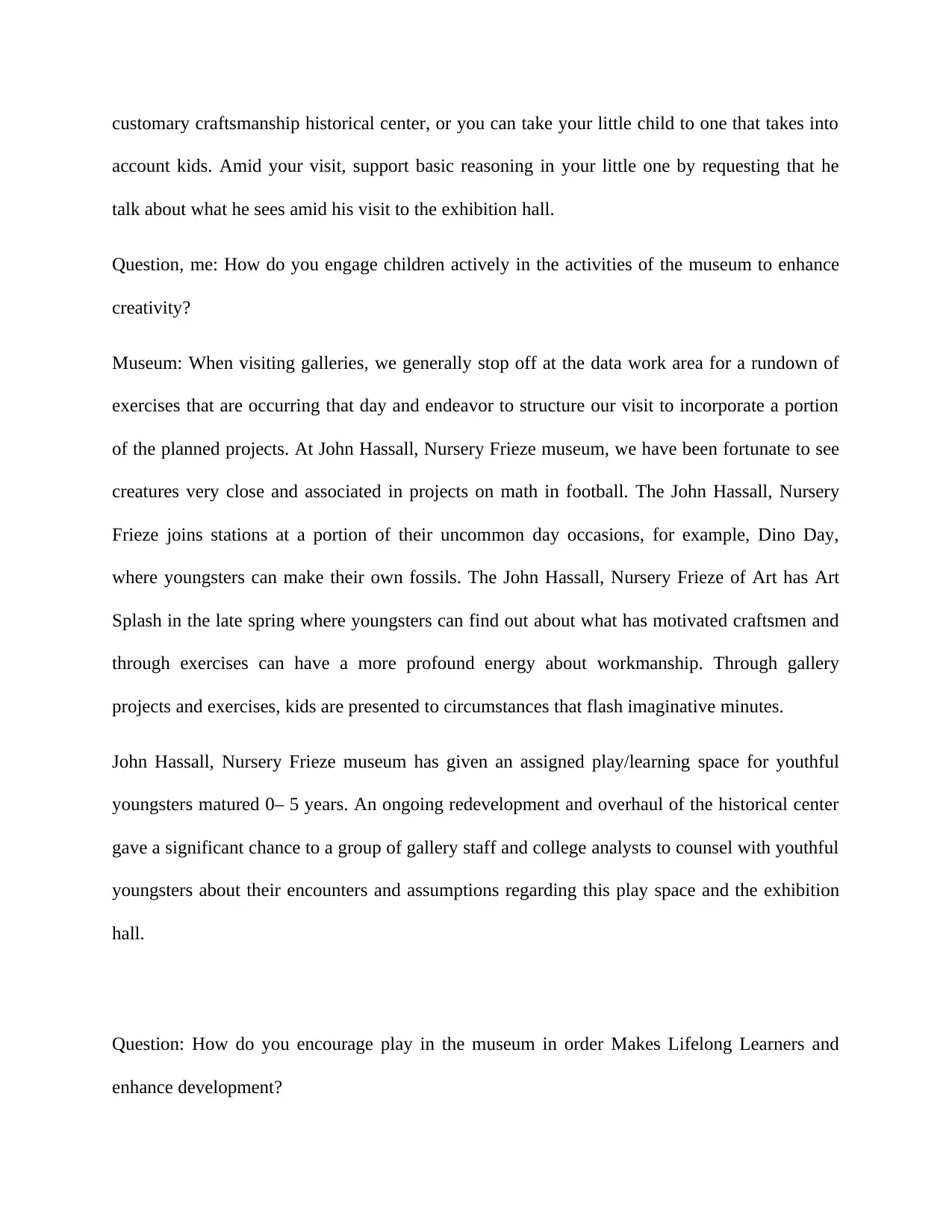
customary craftsmanship historical center, or you can take your little child to one that takes into
account kids. Amid your visit, support basic reasoning in your little one by requesting that he
talk about what he sees amid his visit to the exhibition hall.
Question, me: How do you engage children actively in the activities of the museum to enhance
creativity?
Museum: When visiting galleries, we generally stop off at the data work area for a rundown of
exercises that are occurring that day and endeavor to structure our visit to incorporate a portion
of the planned projects. At John Hassall, Nursery Frieze museum, we have been fortunate to see
creatures very close and associated in projects on math in football. The John Hassall, Nursery
Frieze joins stations at a portion of their uncommon day occasions, for example, Dino Day,
where youngsters can make their own fossils. The John Hassall, Nursery Frieze of Art has Art
Splash in the late spring where youngsters can find out about what has motivated craftsmen and
through exercises can have a more profound energy about workmanship. Through gallery
projects and exercises, kids are presented to circumstances that flash imaginative minutes.
John Hassall, Nursery Frieze museum has given an assigned play/learning space for youthful
youngsters matured 0– 5 years. An ongoing redevelopment and overhaul of the historical center
gave a significant chance to a group of gallery staff and college analysts to counsel with youthful
youngsters about their encounters and assumptions regarding this play space and the exhibition
hall.
Question: How do you encourage play in the museum in order Makes Lifelong Learners and
enhance development?
account kids. Amid your visit, support basic reasoning in your little one by requesting that he
talk about what he sees amid his visit to the exhibition hall.
Question, me: How do you engage children actively in the activities of the museum to enhance
creativity?
Museum: When visiting galleries, we generally stop off at the data work area for a rundown of
exercises that are occurring that day and endeavor to structure our visit to incorporate a portion
of the planned projects. At John Hassall, Nursery Frieze museum, we have been fortunate to see
creatures very close and associated in projects on math in football. The John Hassall, Nursery
Frieze joins stations at a portion of their uncommon day occasions, for example, Dino Day,
where youngsters can make their own fossils. The John Hassall, Nursery Frieze of Art has Art
Splash in the late spring where youngsters can find out about what has motivated craftsmen and
through exercises can have a more profound energy about workmanship. Through gallery
projects and exercises, kids are presented to circumstances that flash imaginative minutes.
John Hassall, Nursery Frieze museum has given an assigned play/learning space for youthful
youngsters matured 0– 5 years. An ongoing redevelopment and overhaul of the historical center
gave a significant chance to a group of gallery staff and college analysts to counsel with youthful
youngsters about their encounters and assumptions regarding this play space and the exhibition
hall.
Question: How do you encourage play in the museum in order Makes Lifelong Learners and
enhance development?
Paraphrase This Document
Need a fresh take? Get an instant paraphrase of this document with our AI Paraphraser
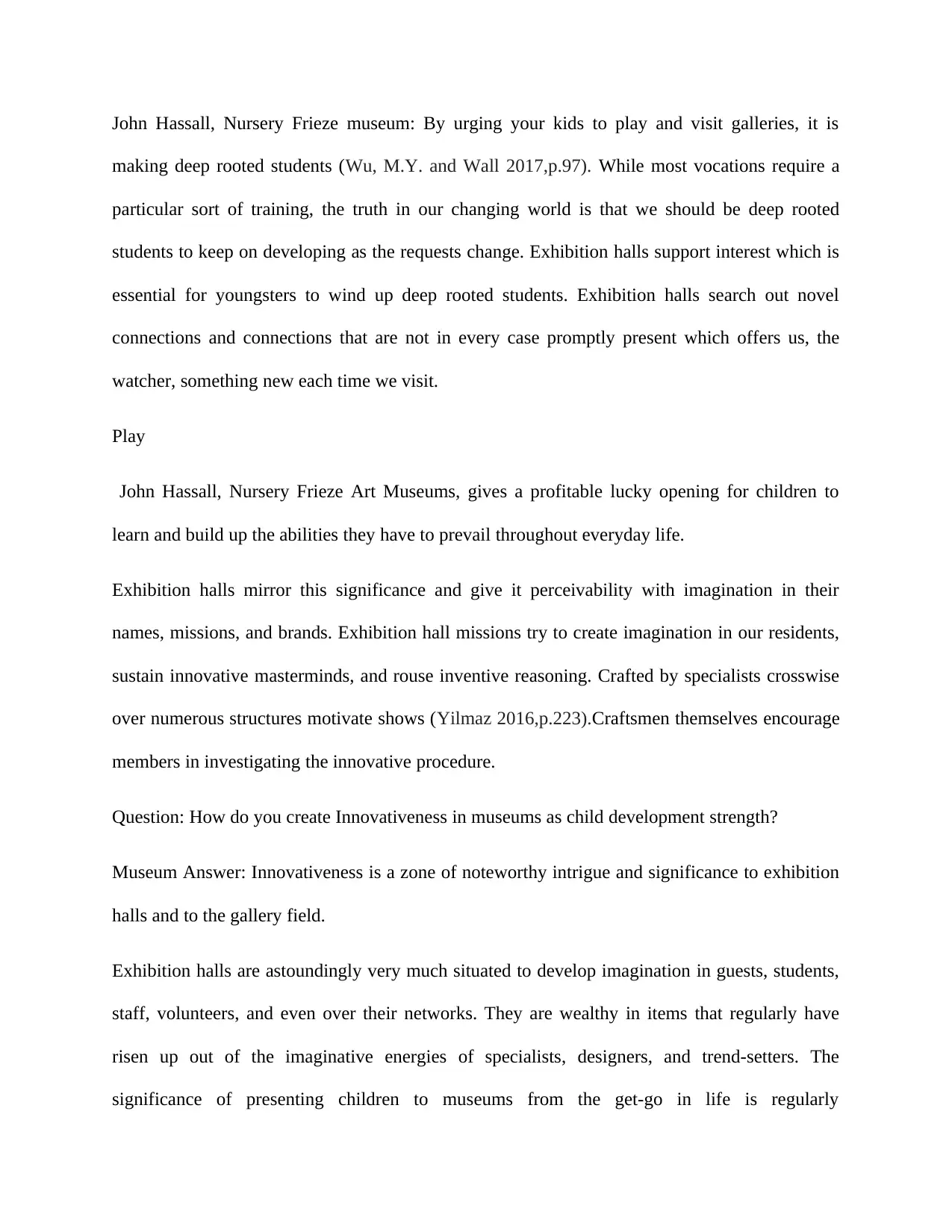
John Hassall, Nursery Frieze museum: By urging your kids to play and visit galleries, it is
making deep rooted students (Wu, M.Y. and Wall 2017,p.97). While most vocations require a
particular sort of training, the truth in our changing world is that we should be deep rooted
students to keep on developing as the requests change. Exhibition halls support interest which is
essential for youngsters to wind up deep rooted students. Exhibition halls search out novel
connections and connections that are not in every case promptly present which offers us, the
watcher, something new each time we visit.
Play
John Hassall, Nursery Frieze Art Museums, gives a profitable lucky opening for children to
learn and build up the abilities they have to prevail throughout everyday life.
Exhibition halls mirror this significance and give it perceivability with imagination in their
names, missions, and brands. Exhibition hall missions try to create imagination in our residents,
sustain innovative masterminds, and rouse inventive reasoning. Crafted by specialists crosswise
over numerous structures motivate shows (Yilmaz 2016,p.223).Craftsmen themselves encourage
members in investigating the innovative procedure.
Question: How do you create Innovativeness in museums as child development strength?
Museum Answer: Innovativeness is a zone of noteworthy intrigue and significance to exhibition
halls and to the gallery field.
Exhibition halls are astoundingly very much situated to develop imagination in guests, students,
staff, volunteers, and even over their networks. They are wealthy in items that regularly have
risen up out of the imaginative energies of specialists, designers, and trend-setters. The
significance of presenting children to museums from the get-go in life is regularly
making deep rooted students (Wu, M.Y. and Wall 2017,p.97). While most vocations require a
particular sort of training, the truth in our changing world is that we should be deep rooted
students to keep on developing as the requests change. Exhibition halls support interest which is
essential for youngsters to wind up deep rooted students. Exhibition halls search out novel
connections and connections that are not in every case promptly present which offers us, the
watcher, something new each time we visit.
Play
John Hassall, Nursery Frieze Art Museums, gives a profitable lucky opening for children to
learn and build up the abilities they have to prevail throughout everyday life.
Exhibition halls mirror this significance and give it perceivability with imagination in their
names, missions, and brands. Exhibition hall missions try to create imagination in our residents,
sustain innovative masterminds, and rouse inventive reasoning. Crafted by specialists crosswise
over numerous structures motivate shows (Yilmaz 2016,p.223).Craftsmen themselves encourage
members in investigating the innovative procedure.
Question: How do you create Innovativeness in museums as child development strength?
Museum Answer: Innovativeness is a zone of noteworthy intrigue and significance to exhibition
halls and to the gallery field.
Exhibition halls are astoundingly very much situated to develop imagination in guests, students,
staff, volunteers, and even over their networks. They are wealthy in items that regularly have
risen up out of the imaginative energies of specialists, designers, and trend-setters. The
significance of presenting children to museums from the get-go in life is regularly
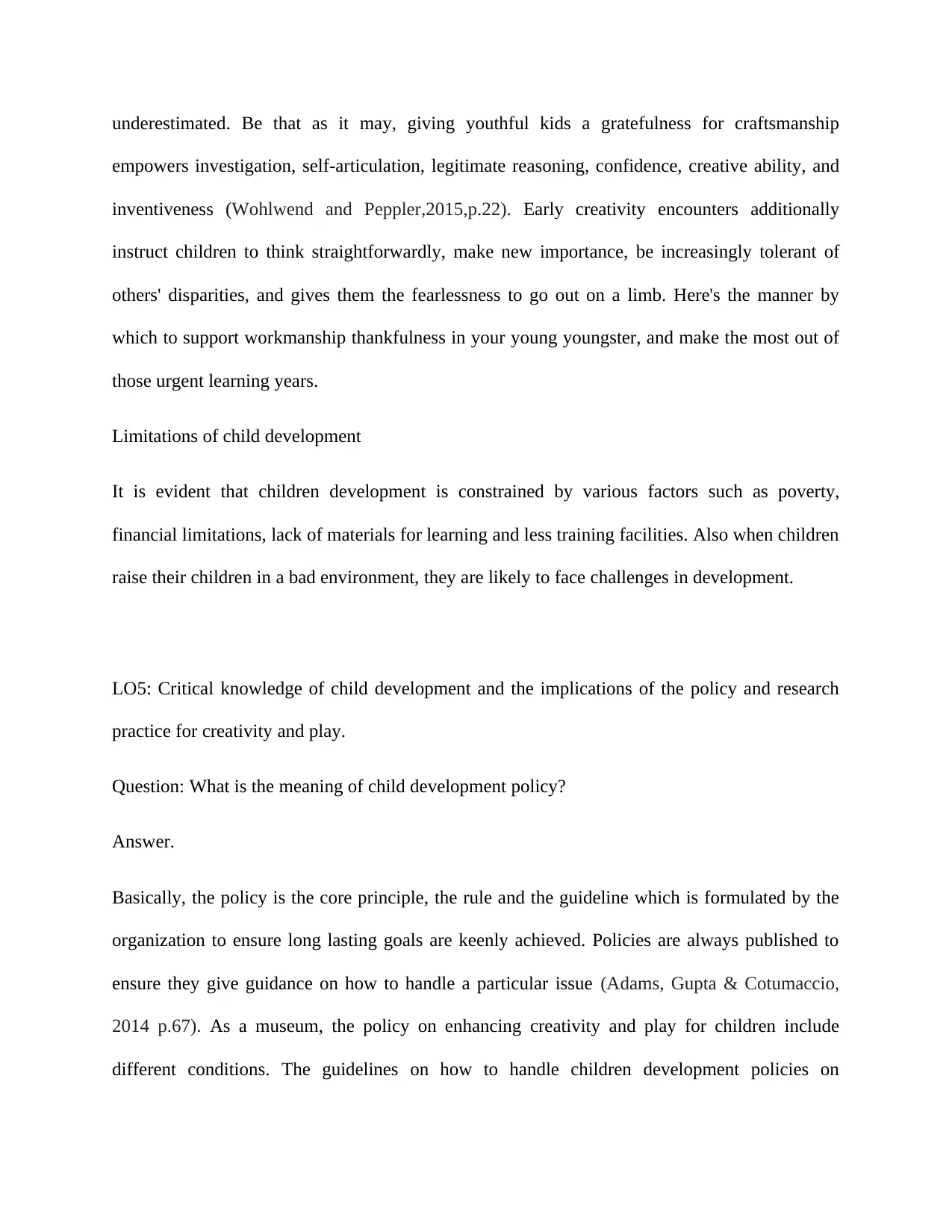
underestimated. Be that as it may, giving youthful kids a gratefulness for craftsmanship
empowers investigation, self-articulation, legitimate reasoning, confidence, creative ability, and
inventiveness (Wohlwend and Peppler,2015,p.22). Early creativity encounters additionally
instruct children to think straightforwardly, make new importance, be increasingly tolerant of
others' disparities, and gives them the fearlessness to go out on a limb. Here's the manner by
which to support workmanship thankfulness in your young youngster, and make the most out of
those urgent learning years.
Limitations of child development
It is evident that children development is constrained by various factors such as poverty,
financial limitations, lack of materials for learning and less training facilities. Also when children
raise their children in a bad environment, they are likely to face challenges in development.
LO5: Critical knowledge of child development and the implications of the policy and research
practice for creativity and play.
Question: What is the meaning of child development policy?
Answer.
Basically, the policy is the core principle, the rule and the guideline which is formulated by the
organization to ensure long lasting goals are keenly achieved. Policies are always published to
ensure they give guidance on how to handle a particular issue (Adams, Gupta & Cotumaccio,
2014 p.67). As a museum, the policy on enhancing creativity and play for children include
different conditions. The guidelines on how to handle children development policies on
empowers investigation, self-articulation, legitimate reasoning, confidence, creative ability, and
inventiveness (Wohlwend and Peppler,2015,p.22). Early creativity encounters additionally
instruct children to think straightforwardly, make new importance, be increasingly tolerant of
others' disparities, and gives them the fearlessness to go out on a limb. Here's the manner by
which to support workmanship thankfulness in your young youngster, and make the most out of
those urgent learning years.
Limitations of child development
It is evident that children development is constrained by various factors such as poverty,
financial limitations, lack of materials for learning and less training facilities. Also when children
raise their children in a bad environment, they are likely to face challenges in development.
LO5: Critical knowledge of child development and the implications of the policy and research
practice for creativity and play.
Question: What is the meaning of child development policy?
Answer.
Basically, the policy is the core principle, the rule and the guideline which is formulated by the
organization to ensure long lasting goals are keenly achieved. Policies are always published to
ensure they give guidance on how to handle a particular issue (Adams, Gupta & Cotumaccio,
2014 p.67). As a museum, the policy on enhancing creativity and play for children include
different conditions. The guidelines on how to handle children development policies on
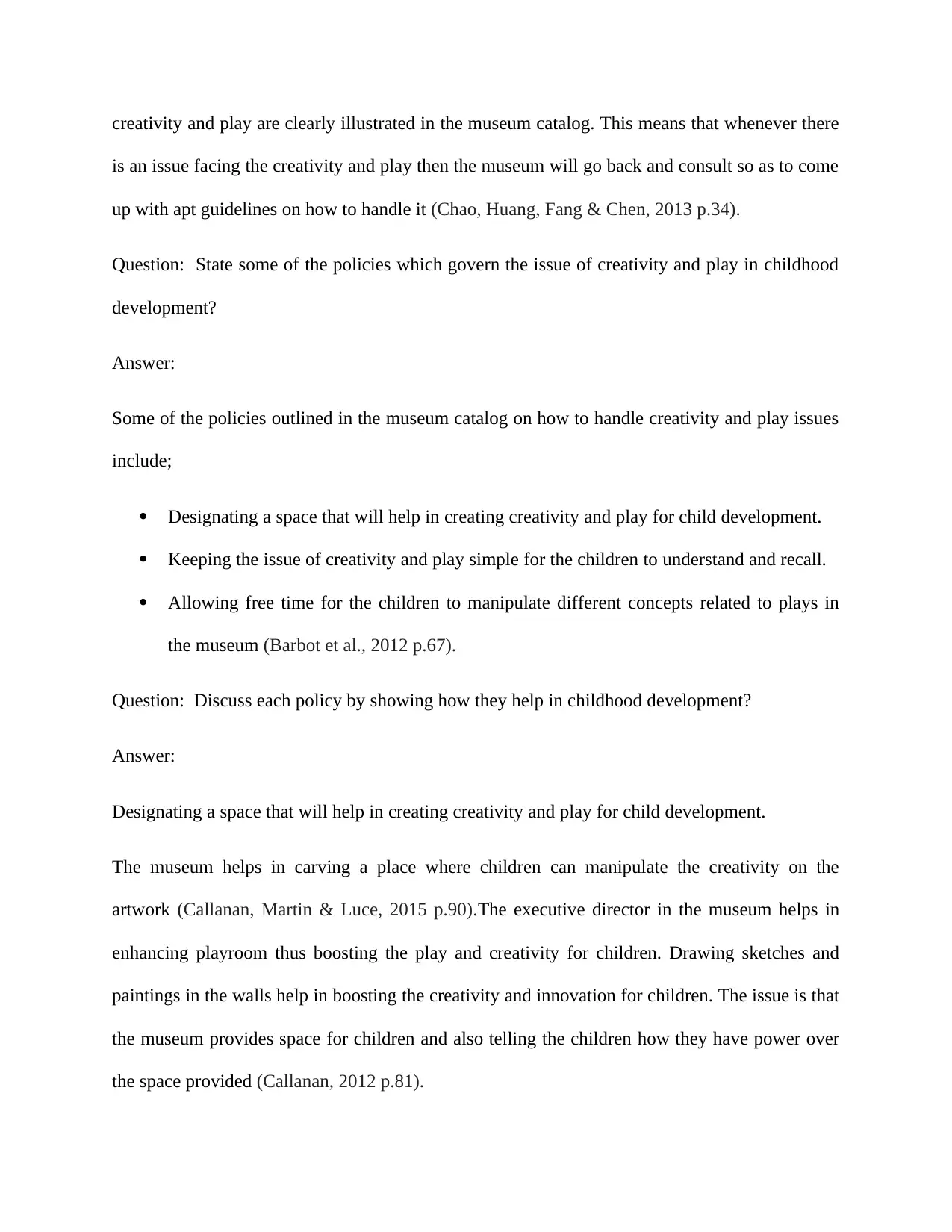
creativity and play are clearly illustrated in the museum catalog. This means that whenever there
is an issue facing the creativity and play then the museum will go back and consult so as to come
up with apt guidelines on how to handle it (Chao, Huang, Fang & Chen, 2013 p.34).
Question: State some of the policies which govern the issue of creativity and play in childhood
development?
Answer:
Some of the policies outlined in the museum catalog on how to handle creativity and play issues
include;
Designating a space that will help in creating creativity and play for child development.
Keeping the issue of creativity and play simple for the children to understand and recall.
Allowing free time for the children to manipulate different concepts related to plays in
the museum (Barbot et al., 2012 p.67).
Question: Discuss each policy by showing how they help in childhood development?
Answer:
Designating a space that will help in creating creativity and play for child development.
The museum helps in carving a place where children can manipulate the creativity on the
artwork (Callanan, Martin & Luce, 2015 p.90).The executive director in the museum helps in
enhancing playroom thus boosting the play and creativity for children. Drawing sketches and
paintings in the walls help in boosting the creativity and innovation for children. The issue is that
the museum provides space for children and also telling the children how they have power over
the space provided (Callanan, 2012 p.81).
is an issue facing the creativity and play then the museum will go back and consult so as to come
up with apt guidelines on how to handle it (Chao, Huang, Fang & Chen, 2013 p.34).
Question: State some of the policies which govern the issue of creativity and play in childhood
development?
Answer:
Some of the policies outlined in the museum catalog on how to handle creativity and play issues
include;
Designating a space that will help in creating creativity and play for child development.
Keeping the issue of creativity and play simple for the children to understand and recall.
Allowing free time for the children to manipulate different concepts related to plays in
the museum (Barbot et al., 2012 p.67).
Question: Discuss each policy by showing how they help in childhood development?
Answer:
Designating a space that will help in creating creativity and play for child development.
The museum helps in carving a place where children can manipulate the creativity on the
artwork (Callanan, Martin & Luce, 2015 p.90).The executive director in the museum helps in
enhancing playroom thus boosting the play and creativity for children. Drawing sketches and
paintings in the walls help in boosting the creativity and innovation for children. The issue is that
the museum provides space for children and also telling the children how they have power over
the space provided (Callanan, 2012 p.81).
Secure Best Marks with AI Grader
Need help grading? Try our AI Grader for instant feedback on your assignments.
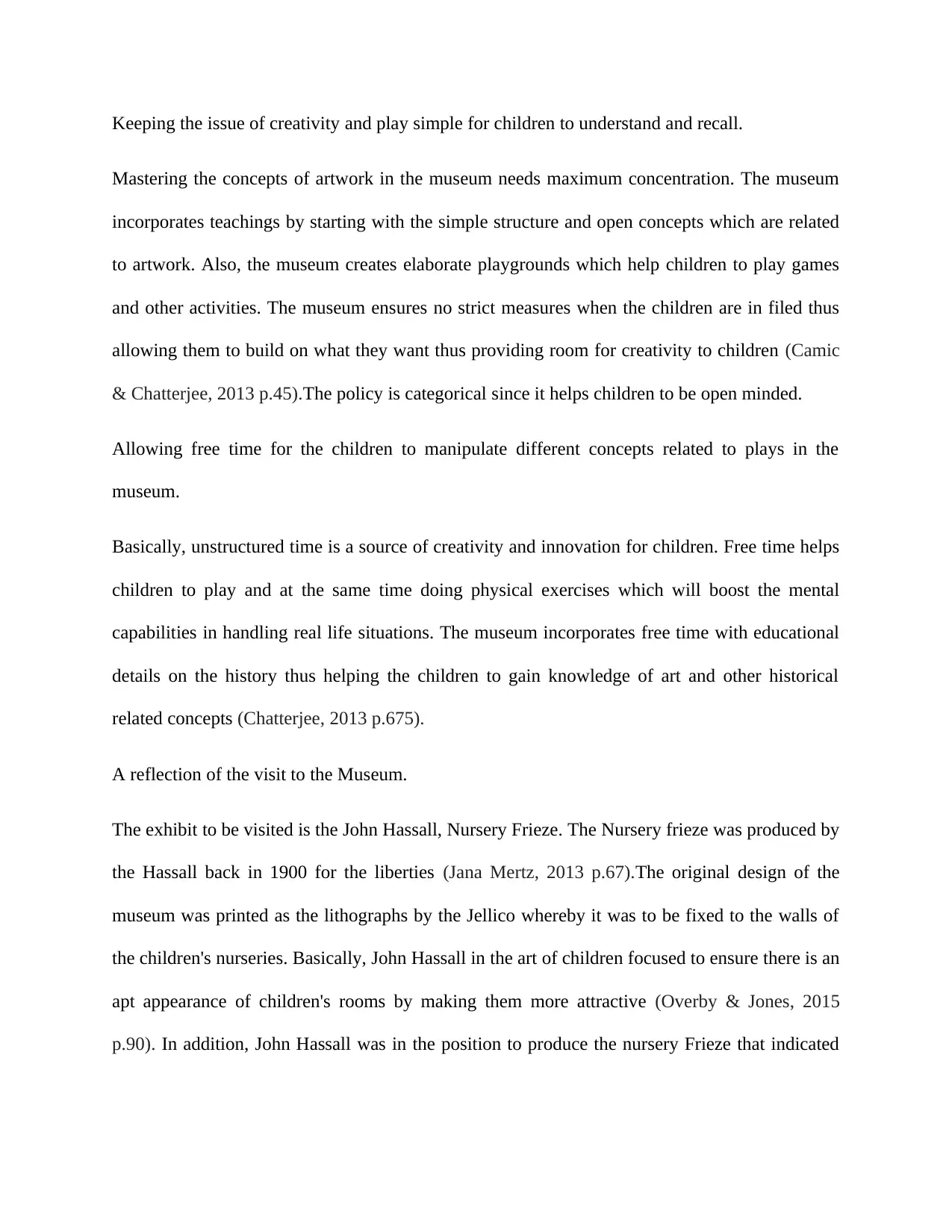
Keeping the issue of creativity and play simple for children to understand and recall.
Mastering the concepts of artwork in the museum needs maximum concentration. The museum
incorporates teachings by starting with the simple structure and open concepts which are related
to artwork. Also, the museum creates elaborate playgrounds which help children to play games
and other activities. The museum ensures no strict measures when the children are in filed thus
allowing them to build on what they want thus providing room for creativity to children (Camic
& Chatterjee, 2013 p.45).The policy is categorical since it helps children to be open minded.
Allowing free time for the children to manipulate different concepts related to plays in the
museum.
Basically, unstructured time is a source of creativity and innovation for children. Free time helps
children to play and at the same time doing physical exercises which will boost the mental
capabilities in handling real life situations. The museum incorporates free time with educational
details on the history thus helping the children to gain knowledge of art and other historical
related concepts (Chatterjee, 2013 p.675).
A reflection of the visit to the Museum.
The exhibit to be visited is the John Hassall, Nursery Frieze. The Nursery frieze was produced by
the Hassall back in 1900 for the liberties (Jana Mertz, 2013 p.67).The original design of the
museum was printed as the lithographs by the Jellico whereby it was to be fixed to the walls of
the children's nurseries. Basically, John Hassall in the art of children focused to ensure there is an
apt appearance of children's rooms by making them more attractive (Overby & Jones, 2015
p.90). In addition, John Hassall was in the position to produce the nursery Frieze that indicated
Mastering the concepts of artwork in the museum needs maximum concentration. The museum
incorporates teachings by starting with the simple structure and open concepts which are related
to artwork. Also, the museum creates elaborate playgrounds which help children to play games
and other activities. The museum ensures no strict measures when the children are in filed thus
allowing them to build on what they want thus providing room for creativity to children (Camic
& Chatterjee, 2013 p.45).The policy is categorical since it helps children to be open minded.
Allowing free time for the children to manipulate different concepts related to plays in the
museum.
Basically, unstructured time is a source of creativity and innovation for children. Free time helps
children to play and at the same time doing physical exercises which will boost the mental
capabilities in handling real life situations. The museum incorporates free time with educational
details on the history thus helping the children to gain knowledge of art and other historical
related concepts (Chatterjee, 2013 p.675).
A reflection of the visit to the Museum.
The exhibit to be visited is the John Hassall, Nursery Frieze. The Nursery frieze was produced by
the Hassall back in 1900 for the liberties (Jana Mertz, 2013 p.67).The original design of the
museum was printed as the lithographs by the Jellico whereby it was to be fixed to the walls of
the children's nurseries. Basically, John Hassall in the art of children focused to ensure there is an
apt appearance of children's rooms by making them more attractive (Overby & Jones, 2015
p.90). In addition, John Hassall was in the position to produce the nursery Frieze that indicated
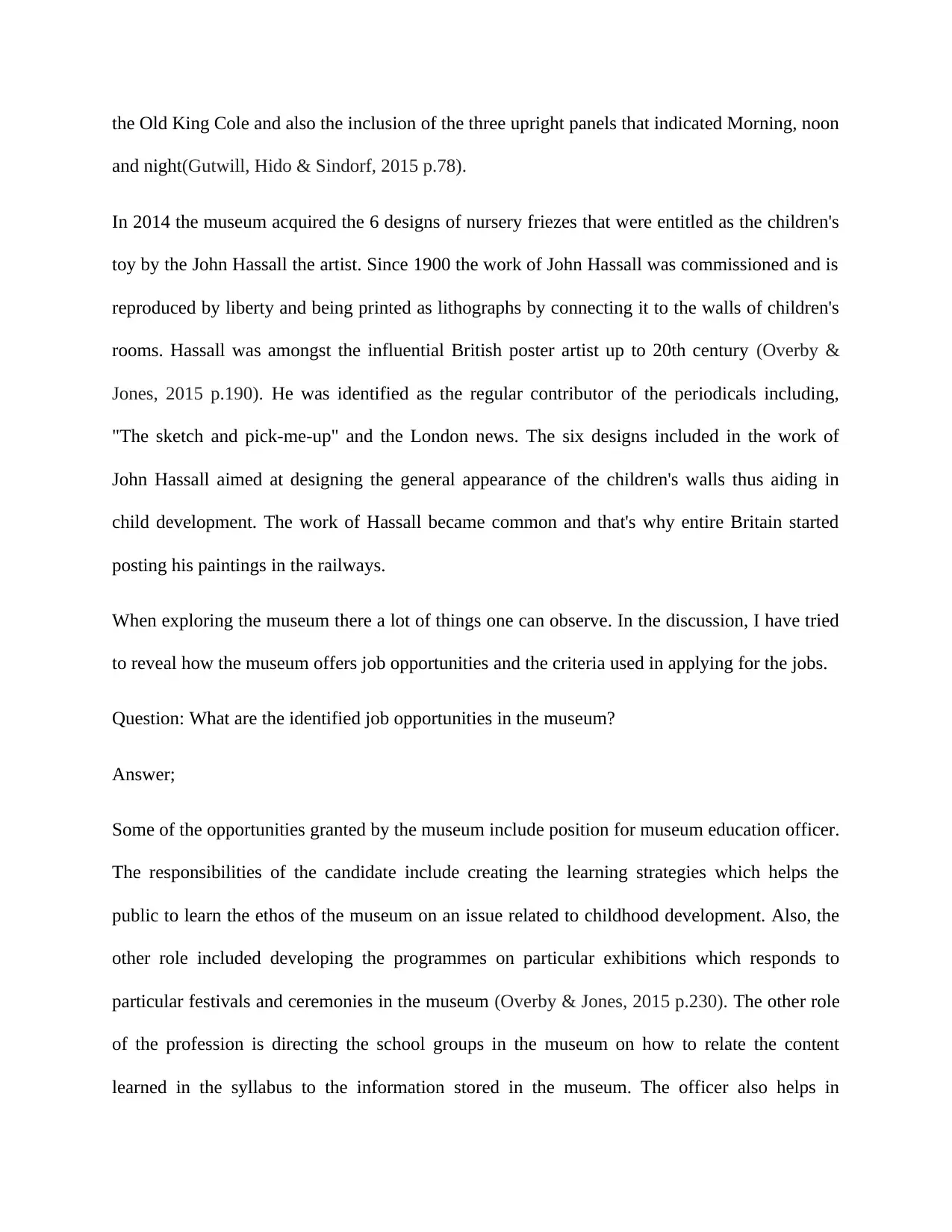
the Old King Cole and also the inclusion of the three upright panels that indicated Morning, noon
and night(Gutwill, Hido & Sindorf, 2015 p.78).
In 2014 the museum acquired the 6 designs of nursery friezes that were entitled as the children's
toy by the John Hassall the artist. Since 1900 the work of John Hassall was commissioned and is
reproduced by liberty and being printed as lithographs by connecting it to the walls of children's
rooms. Hassall was amongst the influential British poster artist up to 20th century (Overby &
Jones, 2015 p.190). He was identified as the regular contributor of the periodicals including,
"The sketch and pick-me-up" and the London news. The six designs included in the work of
John Hassall aimed at designing the general appearance of the children's walls thus aiding in
child development. The work of Hassall became common and that's why entire Britain started
posting his paintings in the railways.
When exploring the museum there a lot of things one can observe. In the discussion, I have tried
to reveal how the museum offers job opportunities and the criteria used in applying for the jobs.
Question: What are the identified job opportunities in the museum?
Answer;
Some of the opportunities granted by the museum include position for museum education officer.
The responsibilities of the candidate include creating the learning strategies which helps the
public to learn the ethos of the museum on an issue related to childhood development. Also, the
other role included developing the programmes on particular exhibitions which responds to
particular festivals and ceremonies in the museum (Overby & Jones, 2015 p.230). The other role
of the profession is directing the school groups in the museum on how to relate the content
learned in the syllabus to the information stored in the museum. The officer also helps in
and night(Gutwill, Hido & Sindorf, 2015 p.78).
In 2014 the museum acquired the 6 designs of nursery friezes that were entitled as the children's
toy by the John Hassall the artist. Since 1900 the work of John Hassall was commissioned and is
reproduced by liberty and being printed as lithographs by connecting it to the walls of children's
rooms. Hassall was amongst the influential British poster artist up to 20th century (Overby &
Jones, 2015 p.190). He was identified as the regular contributor of the periodicals including,
"The sketch and pick-me-up" and the London news. The six designs included in the work of
John Hassall aimed at designing the general appearance of the children's walls thus aiding in
child development. The work of Hassall became common and that's why entire Britain started
posting his paintings in the railways.
When exploring the museum there a lot of things one can observe. In the discussion, I have tried
to reveal how the museum offers job opportunities and the criteria used in applying for the jobs.
Question: What are the identified job opportunities in the museum?
Answer;
Some of the opportunities granted by the museum include position for museum education officer.
The responsibilities of the candidate include creating the learning strategies which helps the
public to learn the ethos of the museum on an issue related to childhood development. Also, the
other role included developing the programmes on particular exhibitions which responds to
particular festivals and ceremonies in the museum (Overby & Jones, 2015 p.230). The other role
of the profession is directing the school groups in the museum on how to relate the content
learned in the syllabus to the information stored in the museum. The officer also helps in
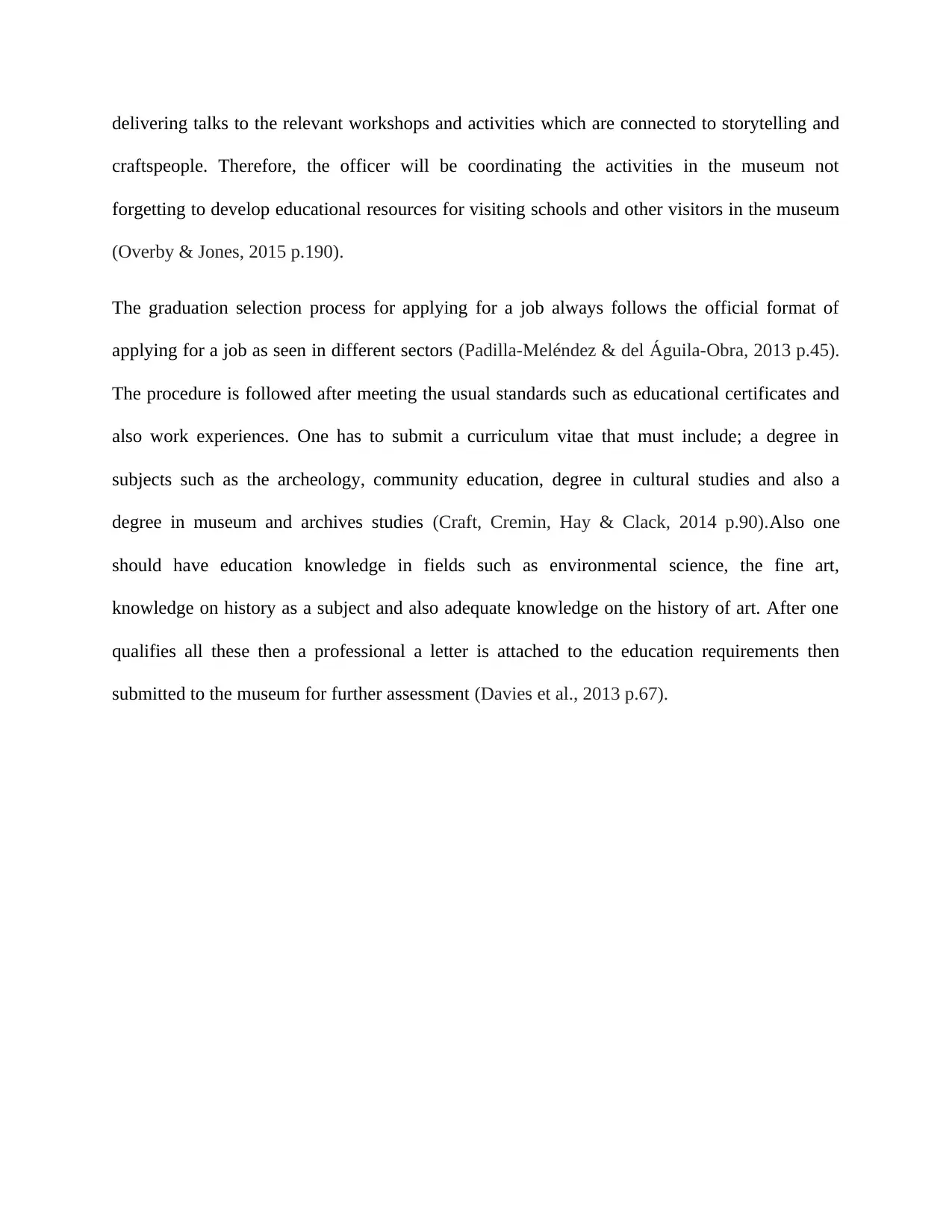
delivering talks to the relevant workshops and activities which are connected to storytelling and
craftspeople. Therefore, the officer will be coordinating the activities in the museum not
forgetting to develop educational resources for visiting schools and other visitors in the museum
(Overby & Jones, 2015 p.190).
The graduation selection process for applying for a job always follows the official format of
applying for a job as seen in different sectors (Padilla-Meléndez & del Águila-Obra, 2013 p.45).
The procedure is followed after meeting the usual standards such as educational certificates and
also work experiences. One has to submit a curriculum vitae that must include; a degree in
subjects such as the archeology, community education, degree in cultural studies and also a
degree in museum and archives studies (Craft, Cremin, Hay & Clack, 2014 p.90).Also one
should have education knowledge in fields such as environmental science, the fine art,
knowledge on history as a subject and also adequate knowledge on the history of art. After one
qualifies all these then a professional a letter is attached to the education requirements then
submitted to the museum for further assessment (Davies et al., 2013 p.67).
craftspeople. Therefore, the officer will be coordinating the activities in the museum not
forgetting to develop educational resources for visiting schools and other visitors in the museum
(Overby & Jones, 2015 p.190).
The graduation selection process for applying for a job always follows the official format of
applying for a job as seen in different sectors (Padilla-Meléndez & del Águila-Obra, 2013 p.45).
The procedure is followed after meeting the usual standards such as educational certificates and
also work experiences. One has to submit a curriculum vitae that must include; a degree in
subjects such as the archeology, community education, degree in cultural studies and also a
degree in museum and archives studies (Craft, Cremin, Hay & Clack, 2014 p.90).Also one
should have education knowledge in fields such as environmental science, the fine art,
knowledge on history as a subject and also adequate knowledge on the history of art. After one
qualifies all these then a professional a letter is attached to the education requirements then
submitted to the museum for further assessment (Davies et al., 2013 p.67).
Paraphrase This Document
Need a fresh take? Get an instant paraphrase of this document with our AI Paraphraser
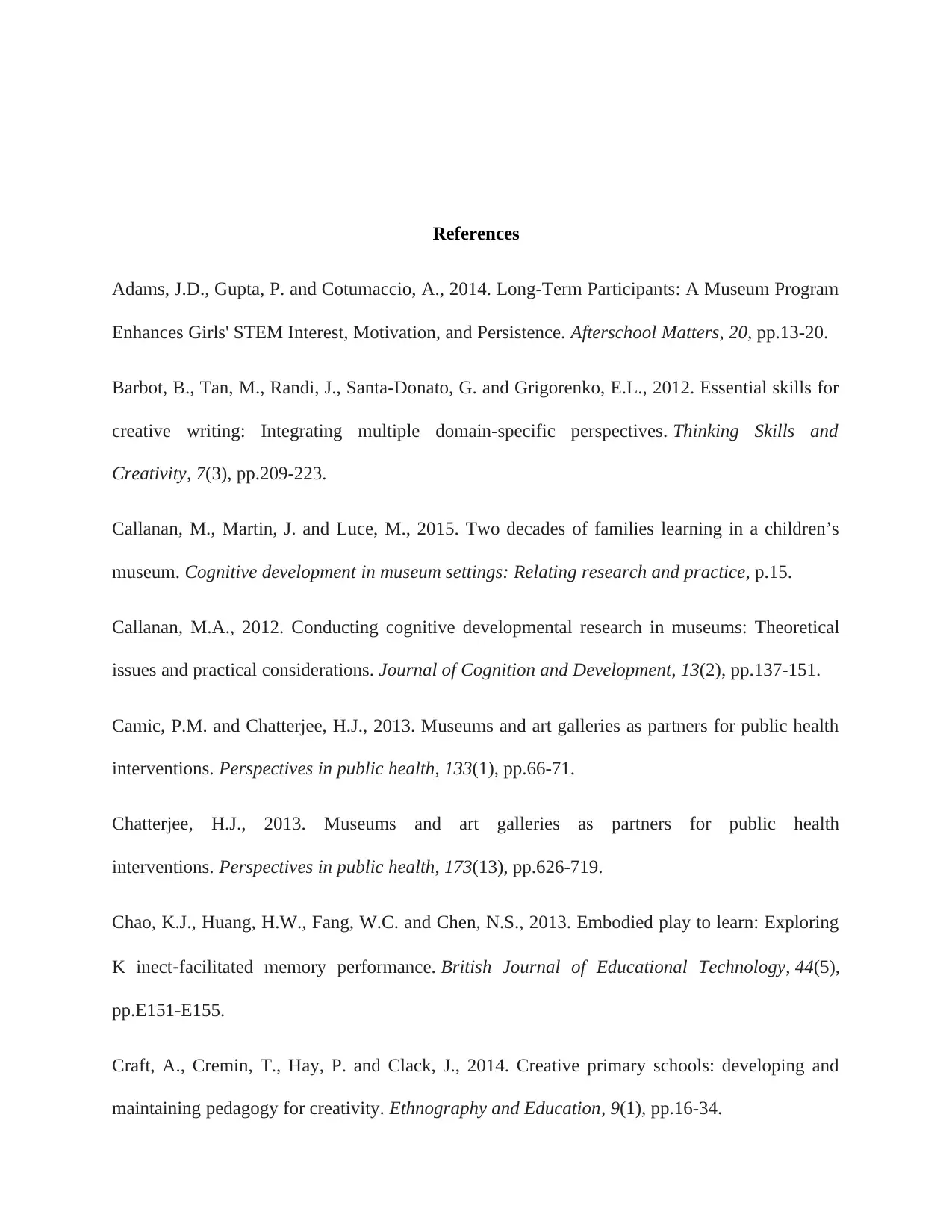
References
Adams, J.D., Gupta, P. and Cotumaccio, A., 2014. Long-Term Participants: A Museum Program
Enhances Girls' STEM Interest, Motivation, and Persistence. Afterschool Matters, 20, pp.13-20.
Barbot, B., Tan, M., Randi, J., Santa-Donato, G. and Grigorenko, E.L., 2012. Essential skills for
creative writing: Integrating multiple domain-specific perspectives. Thinking Skills and
Creativity, 7(3), pp.209-223.
Callanan, M., Martin, J. and Luce, M., 2015. Two decades of families learning in a children’s
museum. Cognitive development in museum settings: Relating research and practice, p.15.
Callanan, M.A., 2012. Conducting cognitive developmental research in museums: Theoretical
issues and practical considerations. Journal of Cognition and Development, 13(2), pp.137-151.
Camic, P.M. and Chatterjee, H.J., 2013. Museums and art galleries as partners for public health
interventions. Perspectives in public health, 133(1), pp.66-71.
Chatterjee, H.J., 2013. Museums and art galleries as partners for public health
interventions. Perspectives in public health, 173(13), pp.626-719.
Chao, K.J., Huang, H.W., Fang, W.C. and Chen, N.S., 2013. Embodied play to learn: Exploring
K inect‐facilitated memory performance. British Journal of Educational Technology, 44(5),
pp.E151-E155.
Craft, A., Cremin, T., Hay, P. and Clack, J., 2014. Creative primary schools: developing and
maintaining pedagogy for creativity. Ethnography and Education, 9(1), pp.16-34.
Adams, J.D., Gupta, P. and Cotumaccio, A., 2014. Long-Term Participants: A Museum Program
Enhances Girls' STEM Interest, Motivation, and Persistence. Afterschool Matters, 20, pp.13-20.
Barbot, B., Tan, M., Randi, J., Santa-Donato, G. and Grigorenko, E.L., 2012. Essential skills for
creative writing: Integrating multiple domain-specific perspectives. Thinking Skills and
Creativity, 7(3), pp.209-223.
Callanan, M., Martin, J. and Luce, M., 2015. Two decades of families learning in a children’s
museum. Cognitive development in museum settings: Relating research and practice, p.15.
Callanan, M.A., 2012. Conducting cognitive developmental research in museums: Theoretical
issues and practical considerations. Journal of Cognition and Development, 13(2), pp.137-151.
Camic, P.M. and Chatterjee, H.J., 2013. Museums and art galleries as partners for public health
interventions. Perspectives in public health, 133(1), pp.66-71.
Chatterjee, H.J., 2013. Museums and art galleries as partners for public health
interventions. Perspectives in public health, 173(13), pp.626-719.
Chao, K.J., Huang, H.W., Fang, W.C. and Chen, N.S., 2013. Embodied play to learn: Exploring
K inect‐facilitated memory performance. British Journal of Educational Technology, 44(5),
pp.E151-E155.
Craft, A., Cremin, T., Hay, P. and Clack, J., 2014. Creative primary schools: developing and
maintaining pedagogy for creativity. Ethnography and Education, 9(1), pp.16-34.
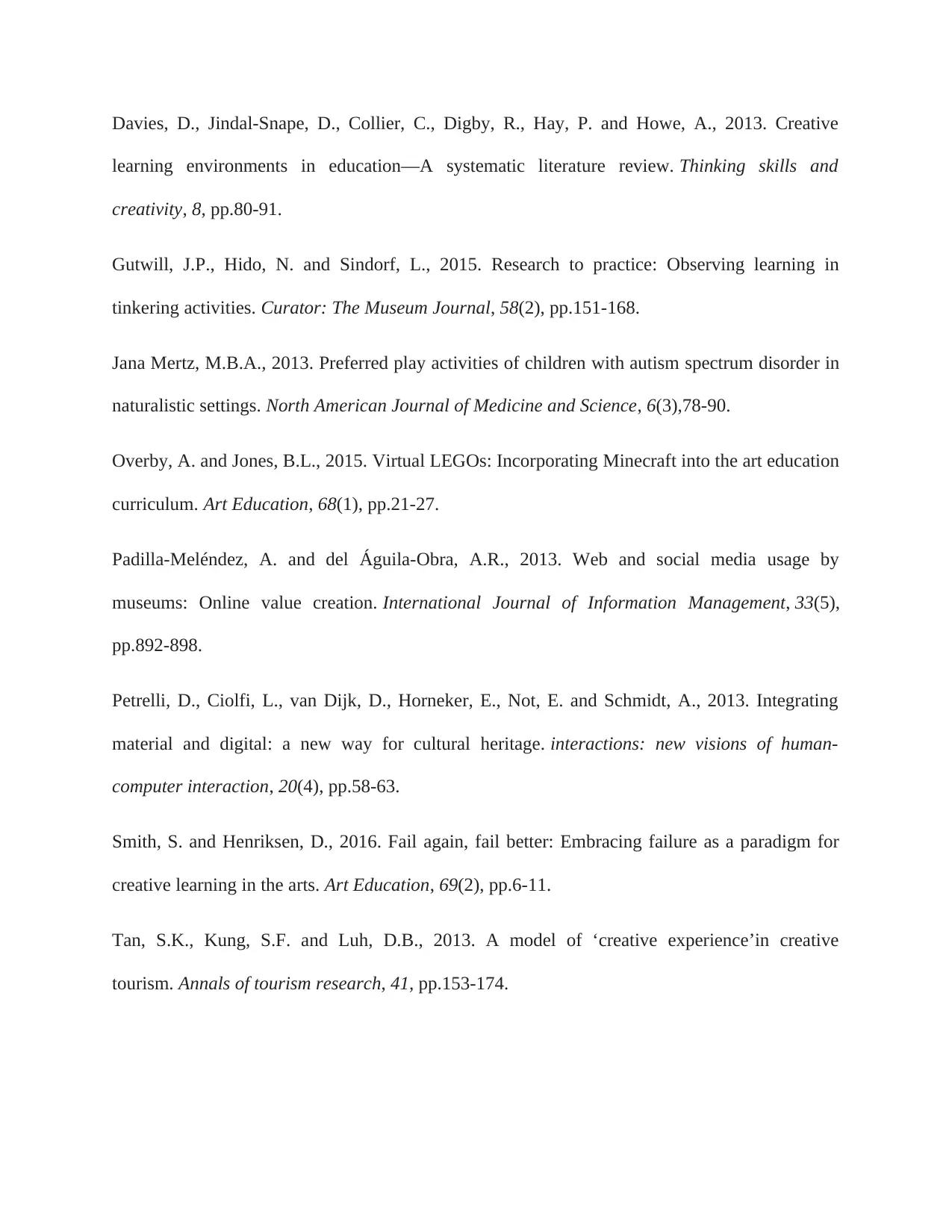
Davies, D., Jindal-Snape, D., Collier, C., Digby, R., Hay, P. and Howe, A., 2013. Creative
learning environments in education—A systematic literature review. Thinking skills and
creativity, 8, pp.80-91.
Gutwill, J.P., Hido, N. and Sindorf, L., 2015. Research to practice: Observing learning in
tinkering activities. Curator: The Museum Journal, 58(2), pp.151-168.
Jana Mertz, M.B.A., 2013. Preferred play activities of children with autism spectrum disorder in
naturalistic settings. North American Journal of Medicine and Science, 6(3),78-90.
Overby, A. and Jones, B.L., 2015. Virtual LEGOs: Incorporating Minecraft into the art education
curriculum. Art Education, 68(1), pp.21-27.
Padilla-Meléndez, A. and del Águila-Obra, A.R., 2013. Web and social media usage by
museums: Online value creation. International Journal of Information Management, 33(5),
pp.892-898.
Petrelli, D., Ciolfi, L., van Dijk, D., Horneker, E., Not, E. and Schmidt, A., 2013. Integrating
material and digital: a new way for cultural heritage. interactions: new visions of human-
computer interaction, 20(4), pp.58-63.
Smith, S. and Henriksen, D., 2016. Fail again, fail better: Embracing failure as a paradigm for
creative learning in the arts. Art Education, 69(2), pp.6-11.
Tan, S.K., Kung, S.F. and Luh, D.B., 2013. A model of ‘creative experience’in creative
tourism. Annals of tourism research, 41, pp.153-174.
learning environments in education—A systematic literature review. Thinking skills and
creativity, 8, pp.80-91.
Gutwill, J.P., Hido, N. and Sindorf, L., 2015. Research to practice: Observing learning in
tinkering activities. Curator: The Museum Journal, 58(2), pp.151-168.
Jana Mertz, M.B.A., 2013. Preferred play activities of children with autism spectrum disorder in
naturalistic settings. North American Journal of Medicine and Science, 6(3),78-90.
Overby, A. and Jones, B.L., 2015. Virtual LEGOs: Incorporating Minecraft into the art education
curriculum. Art Education, 68(1), pp.21-27.
Padilla-Meléndez, A. and del Águila-Obra, A.R., 2013. Web and social media usage by
museums: Online value creation. International Journal of Information Management, 33(5),
pp.892-898.
Petrelli, D., Ciolfi, L., van Dijk, D., Horneker, E., Not, E. and Schmidt, A., 2013. Integrating
material and digital: a new way for cultural heritage. interactions: new visions of human-
computer interaction, 20(4), pp.58-63.
Smith, S. and Henriksen, D., 2016. Fail again, fail better: Embracing failure as a paradigm for
creative learning in the arts. Art Education, 69(2), pp.6-11.
Tan, S.K., Kung, S.F. and Luh, D.B., 2013. A model of ‘creative experience’in creative
tourism. Annals of tourism research, 41, pp.153-174.
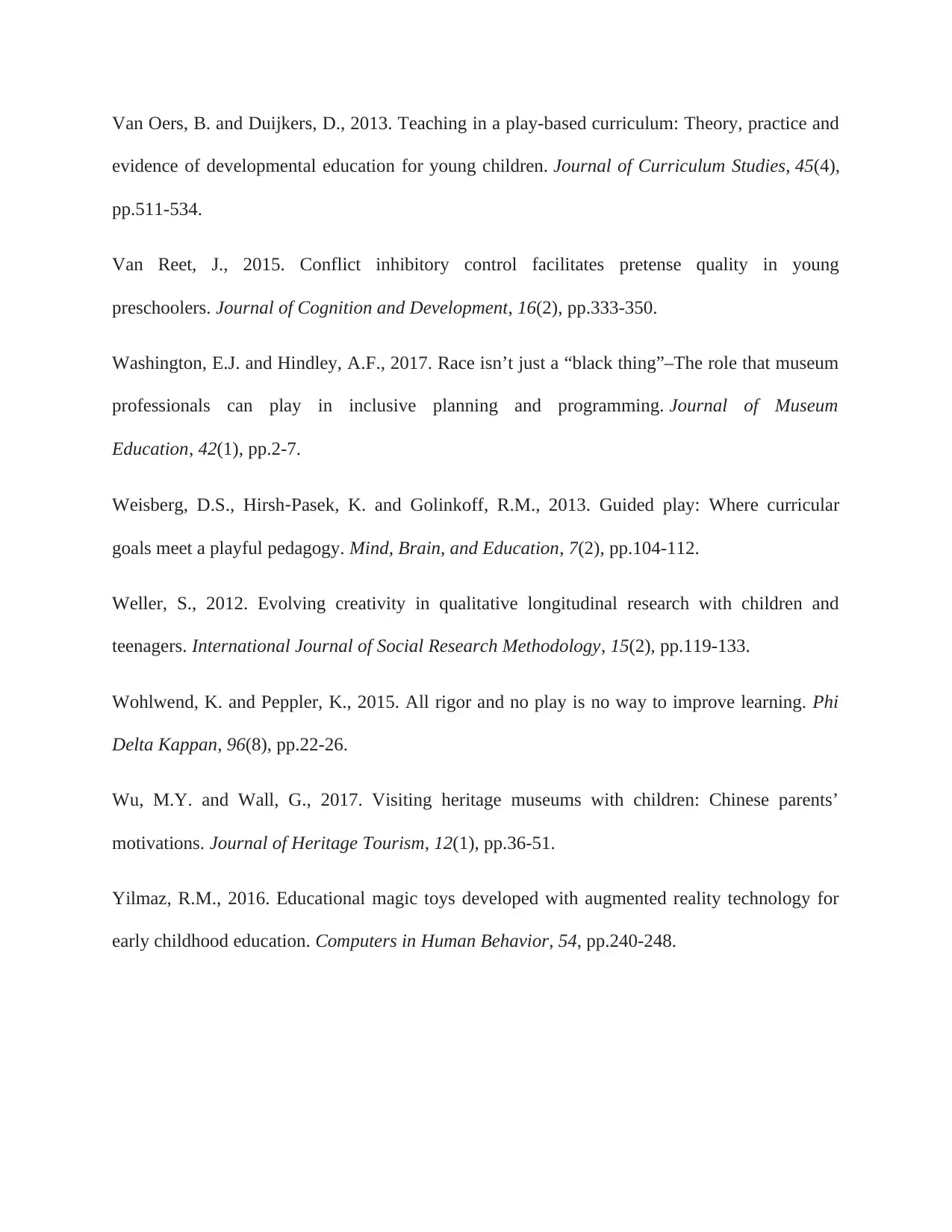
Van Oers, B. and Duijkers, D., 2013. Teaching in a play-based curriculum: Theory, practice and
evidence of developmental education for young children. Journal of Curriculum Studies, 45(4),
pp.511-534.
Van Reet, J., 2015. Conflict inhibitory control facilitates pretense quality in young
preschoolers. Journal of Cognition and Development, 16(2), pp.333-350.
Washington, E.J. and Hindley, A.F., 2017. Race isn’t just a “black thing”–The role that museum
professionals can play in inclusive planning and programming. Journal of Museum
Education, 42(1), pp.2-7.
Weisberg, D.S., Hirsh‐Pasek, K. and Golinkoff, R.M., 2013. Guided play: Where curricular
goals meet a playful pedagogy. Mind, Brain, and Education, 7(2), pp.104-112.
Weller, S., 2012. Evolving creativity in qualitative longitudinal research with children and
teenagers. International Journal of Social Research Methodology, 15(2), pp.119-133.
Wohlwend, K. and Peppler, K., 2015. All rigor and no play is no way to improve learning. Phi
Delta Kappan, 96(8), pp.22-26.
Wu, M.Y. and Wall, G., 2017. Visiting heritage museums with children: Chinese parents’
motivations. Journal of Heritage Tourism, 12(1), pp.36-51.
Yilmaz, R.M., 2016. Educational magic toys developed with augmented reality technology for
early childhood education. Computers in Human Behavior, 54, pp.240-248.
evidence of developmental education for young children. Journal of Curriculum Studies, 45(4),
pp.511-534.
Van Reet, J., 2015. Conflict inhibitory control facilitates pretense quality in young
preschoolers. Journal of Cognition and Development, 16(2), pp.333-350.
Washington, E.J. and Hindley, A.F., 2017. Race isn’t just a “black thing”–The role that museum
professionals can play in inclusive planning and programming. Journal of Museum
Education, 42(1), pp.2-7.
Weisberg, D.S., Hirsh‐Pasek, K. and Golinkoff, R.M., 2013. Guided play: Where curricular
goals meet a playful pedagogy. Mind, Brain, and Education, 7(2), pp.104-112.
Weller, S., 2012. Evolving creativity in qualitative longitudinal research with children and
teenagers. International Journal of Social Research Methodology, 15(2), pp.119-133.
Wohlwend, K. and Peppler, K., 2015. All rigor and no play is no way to improve learning. Phi
Delta Kappan, 96(8), pp.22-26.
Wu, M.Y. and Wall, G., 2017. Visiting heritage museums with children: Chinese parents’
motivations. Journal of Heritage Tourism, 12(1), pp.36-51.
Yilmaz, R.M., 2016. Educational magic toys developed with augmented reality technology for
early childhood education. Computers in Human Behavior, 54, pp.240-248.
Secure Best Marks with AI Grader
Need help grading? Try our AI Grader for instant feedback on your assignments.

1 out of 17
Related Documents
Your All-in-One AI-Powered Toolkit for Academic Success.
+13062052269
info@desklib.com
Available 24*7 on WhatsApp / Email
![[object Object]](/_next/static/media/star-bottom.7253800d.svg)
Unlock your academic potential
© 2024 | Zucol Services PVT LTD | All rights reserved.





